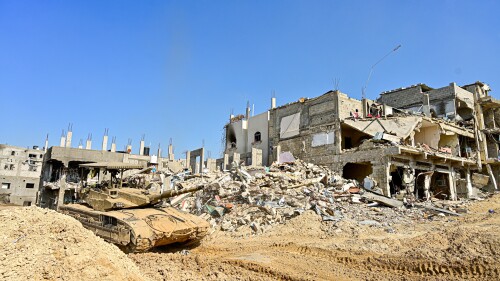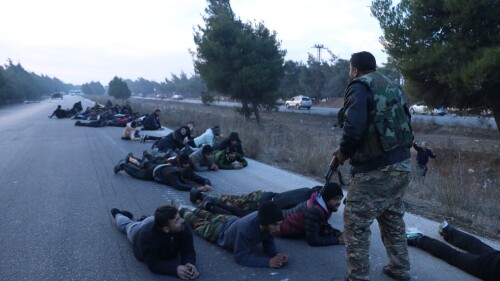An Israeli airstrike killed four Syrian soldiers in an attack on targets in the Damascus area Sunday night, according to reports in foreign and regional media. The pro-regime SANA news agency confirmed that “Four army personnel were martyred, and four others were injured.”
The Opposition-linked Syrian Observatory for Human Rights (SOHR), meanwhile, gave a slightly different figure, writing, “Israeli airstrikes targeted, in the early hours of Monday morning, several positions hosting warehouses and military posts of Iranian-backed militias in the vicinity of the area of Damascus International Airport, the area of Demas Airport and the surrounding areas of Al-Keswa to the west of Damascus.” The Observatory also reported that “four regime soldiers” were killed, but added that two other “unidentified persons” also died.
This latest strike is part of an apparent increased tempo of Israeli operations against the Iranian infrastructure in Syria. Again according to SOHR, Monday’s attack was the latest in a total of 22 attacks carried out by Israeli forces against Syria in the course of 2023. The Observatory reports that 79 people have been killed in these attacks, including six members of Iran’s Islamic Revolutionary Guards Corps (IRGC) and three members of Lebanese Hezbollah, as well as 22 IRGC-backed non-Syrian militiamen, and four IRGC-backed Syrian militiamen. The bulk of the remaining casualties were members of the Syrian regime’s security forces.
If SOHR’s figures are accurate, or close to accuracy, this represents a considerable death toll. Israel’s actions this year, of course, are part of a longer campaign. Jerusalem’s “war between wars,” or MABAM in Hebrew, has been prosecuted for over a decade now. Without doubt, it has left a trail of destroyed ordnance, shattered convoys, and dead operatives across Syria. Israeli national security officials past and present appear satisfied with the progress made. Some 80% of what Iran would like to have had in place by now in terms of infrastructure facing Israel has been neutralized, according to one estimate.
If Israel is perceived as largely acquiescing to rules of the game imposed by Iran, this will lead to a decline in Israel’s deterrent power, making further aggressive moves by Iranian proxies more likely.
Yet there is room for asking whether the situation is really as optimal as is often presented. Specifically, the question is whether the war between wars is addressing the totality of the Iranian project to Israel’s North, or whether, as a result of the undoubted successes in one particular area (the targeting, by air power or occasionally by artillery, based on successful intelligence gathering, of specific Iranian static or moving targets in Syria), Israel has allowed itself to be channeled into only focusing on that area.
IF THE LATTER is the case, it would mean that large and perhaps decisive parts of the Iranian project are being left to themselves, and are growing in strength, with Israel deterred by political or military means from striking at them. The situation is not static, since if Israel is perceived as largely acquiescing to rules of the game imposed by Iran, this will lead to a decline in Israel’s deterrent power, making further aggressive moves by Iranian proxies more likely.
Unfortunately, and despite Israel’s ongoing air campaign, a considerable body of evidence exists in support of this perception. The emerging picture is one in which Iran is operating its various proxies in Iraq, Syria, and Lebanon as a single structure, without excessive reference to formal state borders. Israel, meanwhile, because of political and military constraints, is attacking only a limited number of elements within this structure.
Perhaps most significantly, the latest evidence suggests that significant parts of the formal structure of the Assad regime in Syria itself are today operating as fully-fledged elements of the Iranian project.
In the field of arms shipments, for example, the Syrian National Defense Forces, the 4th Armored Division, the Air Force Intelligence Directorate, and elements of the Border Guard all act in cooperation with the IRGC, Lebanese Hezbollah, and the Iraqi Shia militias in the process of shipping arms by land, sea, and air to the various components of the Iranian structure between the Iraq-Iran border and the Mediterranean Sea (and perhaps beyond). The IRGC, that is Iran, is the senior, controlling element in this process.
Recent reports by the Alma Research and Education Center, which focuses on the challenges to Israel’s North, detail how CERS, the Syrian Scientific Studies and Research Center, has come under direct IRGC and Lebanese Hezbollah control. According to the report, CERS, which employs around 20,000 personnel, is engaged in production and development of advanced weapons systems, including chemical and biological weapons. An additional report from the same source describes the wholesale assimilation of an IRGC-linked militia, the Imam Ali Brigade, into the 4th Division. The report notes that “the 4th Division has evolved into an Iranian proxy, reporting directly to the Quds Force, which conducts direct offensive operations against Israel and American soldiers in Syria.”
It should be noted that weaponry making its way from Jordan into the West Bank, in particular more sophisticated forms of armament, has first to be brought into Jordan.
In the area of smuggling of the amphetamine-type stimulant Captagon, which has become a crucial source of income for the Iranian-led bloc in this area, a similar level of unification pertains. The drugs are produced in Lebanon and Syria and smuggled across the border from Syria to Jordan. Participating in this process are, once more, the 4th Division and Air Force Intelligence, along with Hezbollah, southern Bedouin tribes such as the al-Nauaimi, who work in close cooperation with Hezbollah, and elements of the Syrian Border Guard trusted by the Iranian element. The IRGC manages the process. Try figuring out from that list where Iran begins and its proxies, including the Syrian regime, end.
THE SMUGGLING routes across the border are known for the transfer of drugs. Might other materials, including weaponry and ammunition also be transported the same way, and by the same networks? It certainly seems plausible. As is well known, the weaponry for the Iran-supported emergent militias of Jenin and Nablus largely enters from Jordan.
A week ago, the Israeli media reported that an “unusual” attempt at smuggling had been intercepted near Ashdot Yaacov in the Jordan Valley. No further information regarding the unusual nature of the attempt has emerged. But it should be noted that weaponry making its way from Jordan into the West Bank, in particular more sophisticated forms of armament, has first to be brought into Jordan.
Iranian project operates across borders
What may be glimpsed from all these examples is that the Iranian project operates across borders, with a clear hierarchy of control, and without regard to the distinctions separating countries, or separating supposedly sovereign governments in Iraq, Syria and Lebanon from the Iranian interest. Israel, by contrast, does respect these distinctions. It leaves Iraq alone, and avoids attacking the Syrian regime (thereby also avoiding attacking the manifold Iranian assets which today exist under the official banner of the regime, as well as those elements of the regime which today work in close cooperation with the IRGC.) Perhaps most serious of all, in Lebanon, Israel accepts a situation of mutual deterrence with Hezbollah, the IRGC’s oldest franchise, and as a consequence, largely leaves it to itself.
In Lebanon, Israel accepts a situation of mutual deterrence with Hezbollah, the IRGC’s oldest franchise, and as a consequence, largely leaves it to itself.
The end result of all this, it seems, is a growing confidence and even recklessness on the part of the enemy. This cannot be traced only to the current internal unrest in Israel. Iranian outlets have been talking about the “unification of the fronts” since Ramadan of 2021.
In March, an ominous incident took place in which an operative came from Hezbollah-controlled southern Lebanon down to Megiddo, carrying a powerful improvised explosive device. In April, 34 rockets were launched from southern Lebanon, with the certain knowledge of Hezbollah. In early July, an anti-tank missile was launched at Ghajar, on Israel’s northern border. This is without reference to the legion of lesser provocations also taking place along the border, including the placing of temporary structures on Israeli soil by Hezbollah.
The continued successes of Israeli air power over Syria are worthy of note. Nevertheless, given the broader realities outlined here, the increasingly urgent question is whether the current dimensions of the war between wars remain adequate for addressing the task at hand, namely, the need to strike at the full fabric of the Iranian effort to Israel’s North, both in order to substantively weaken this effort and to rebuild deterrence against its most forward elements.
Choosing not to decide on this matter is also a choice, namely the choice to acquiesce to the continued Iranian advance.








